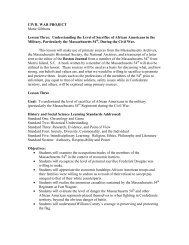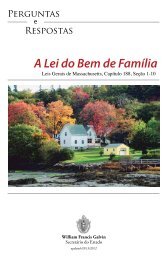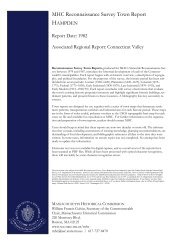Roads, Rails, and Trails - Secretary of the Commonwealth
Roads, Rails, and Trails - Secretary of the Commonwealth
Roads, Rails, and Trails - Secretary of the Commonwealth
You also want an ePaper? Increase the reach of your titles
YUMPU automatically turns print PDFs into web optimized ePapers that Google loves.
Eventually nineteen different sites were excavated.<br />
These sites combined contained a record <strong>of</strong> people’s daily lives<br />
extending from 8,000 B.C. to 1500 A.D. More than 180,000<br />
artifacts were excavated, recorded, analyzed, <strong>and</strong> curated for<br />
future study. The archaeologists also identified hundreds <strong>of</strong><br />
archaeological features.<br />
At a site named Canoe River West, located near <strong>the</strong><br />
Canoe River in Norton, <strong>the</strong> archaeologists uncovered three<br />
large platforms made <strong>of</strong> rocks. The rocks had been reddened<br />
<strong>and</strong> cracked by exposure to heat, <strong>and</strong> among <strong>the</strong> rocks <strong>the</strong><br />
archaeologists found many bits <strong>of</strong> charcoal. The archaeologists<br />
concluded that <strong>the</strong> platforms had underlain fires for cooking,<br />
smoking, <strong>and</strong> drying fish that had been caught in <strong>the</strong> river. But<br />
<strong>the</strong> platforms were only part <strong>of</strong> <strong>the</strong> story. When <strong>the</strong><br />
archaeologists dug beneath <strong>the</strong> platforms <strong>the</strong>y found many<br />
filled-in storage pits that had been used to store <strong>the</strong> smoked <strong>and</strong><br />
dried fish.<br />
Apparently, <strong>the</strong> Canoe River West site was a favorite<br />
fishing spot that was returned to year after year for thous<strong>and</strong>s<br />
<strong>of</strong> years. In those days <strong>the</strong> Canoe River, like many o<strong>the</strong>r<br />
Massachusetts rivers, would have been filled with fish every<br />
spring as shad, salmon, <strong>and</strong> o<strong>the</strong>r kinds <strong>of</strong> fish swam upstream<br />
to spawn in freshwater lakes <strong>and</strong> brooks. The Native American<br />
people trapped <strong>the</strong> fish in weirs, caught <strong>the</strong>m with nets or<br />
spears, cooked some to eat right away, <strong>and</strong> smoked <strong>and</strong> dried<br />
<strong>the</strong> rest for later. This was an important part <strong>of</strong> <strong>the</strong> settlement<br />
system, a time <strong>of</strong> year when people could ga<strong>the</strong>r toge<strong>the</strong>r in<br />
large groups, with plenty <strong>of</strong> food at h<strong>and</strong>. They built <strong>the</strong> rock<br />
platforms, or reused platforms from previous years, kindled<br />
fires on <strong>the</strong>m for smoking <strong>the</strong> fish, <strong>and</strong> dug pits in which <strong>the</strong>y<br />
stored <strong>the</strong> preserved fish (probably inside closely-woven<br />
baskets). Some <strong>of</strong> <strong>the</strong> rock platforms were built right over<br />
older, filled-in storage pits.<br />
5<br />
Rock Platform from <strong>the</strong> Canoe River West Site<br />
Ano<strong>the</strong>r site, named <strong>the</strong> Rozenas I site in Raynham,<br />
also had evidence <strong>of</strong> repeated occupation over thous<strong>and</strong>s <strong>of</strong><br />
years. At this site <strong>the</strong> archaeologists were able to distinguish<br />
some distinct activity areas for living, manufacturing stone<br />
tools, butchering animals, <strong>and</strong> preparing meals. Although <strong>the</strong><br />
site was occupied over thous<strong>and</strong>s <strong>of</strong> years, much <strong>of</strong> <strong>the</strong><br />
occupation dated to around 1500 A.D., just before contact with<br />
Europeans. The most ancient <strong>of</strong> <strong>the</strong> sites was <strong>the</strong> Double P site,<br />
which contained artifacts <strong>and</strong> features that were more than<br />
8,000 years old.








